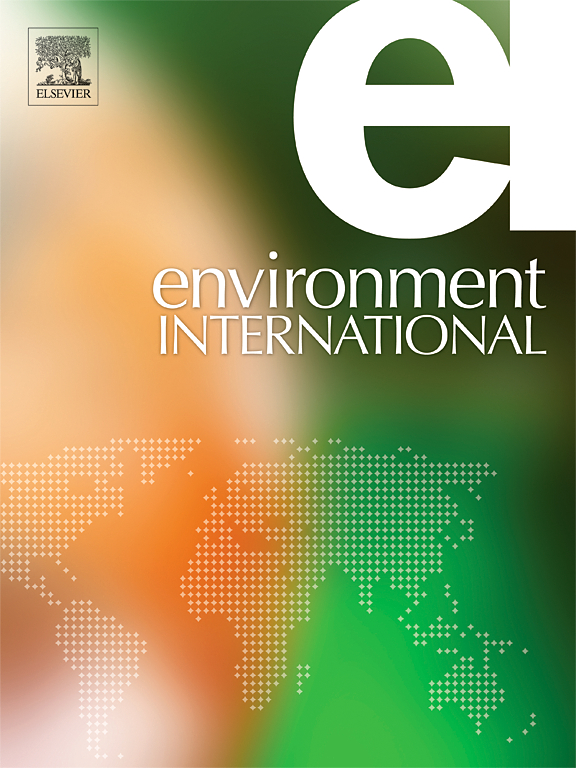Navigating the complexity of exposure to multiclass organic pollutants in respirable size-resolved particles and implications for oxidative potential
IF 10.3
1区 环境科学与生态学
Q1 ENVIRONMENTAL SCIENCES
引用次数: 0
Abstract
Chronic exposure to inhalable atmospheric particulate matter is linked to millions of annual premature deaths globally. Yet the sources and factors driving oxidative potential (OP) remain poorly understood, especially regarding the coexistence of multi-organic pollutants. This longitudinal study examined the size-distribution, respiratory deposition efficiency and daily exposure of 41 chemicals covering polycyclic aromatic hydrocarbons (PAHs), brominated flame retardants (BFRs), and phthalates (PAEs), as well as the dithiothreitol-based OP in size-fractioned PM10 from distinct waste recycling plants in Guangzhou, South China. From September to December 2020, five parallel samples were successively collected within each of the four plants using an eight-stage cascade sampler. The particle size-dependent correlations were explored between co-existing pollutants and acellular OP, with a weighted quantile sum regression model to rank the relative contribution ratios. The ∑8PAE levels in PM10 were 100 and 1000 times higher than those of ∑16PAH and ∑17BFR respectively, aligning with the exposure outcomes of dermal contact and inhalation pathways. Compounds in the coarse fractions of PM9.0–10 primarily deposited in the upper respiratory tract, while 37%–73% in pulmonary alveoli were attributed to finer PM2.1. The high-molecular-weight PAHs and BFRs in PM9.0–10 were more effective in enhancing OP generation than PAEs, with benzo[g,h,i]perylene identified as the most potent oxidizing agent with the highest weight (22%). The findings underscore that elevated pollution burden doses may not necessarily represent severe oxidative toxicity, and the targeted prevention strategies are warranted to mitigate oxidative toxicity from respirable particle.


导航的复杂性暴露于多类有机污染物在可呼吸的大小分解颗粒和氧化电位的影响
长期暴露于可吸入大气颗粒物与全球每年数百万人过早死亡有关。然而,氧化电位(OP)的来源和驱动因素仍然知之甚少,特别是在多种有机污染物共存的情况下。这项纵向研究调查了41种化学物质的大小分布、呼吸沉积效率和每日暴露量,包括多环芳烃(PAHs)、溴化阻燃剂(BFRs)和邻苯二甲酸酯(PAEs),以及来自中国南方广州不同废物回收厂的PM10大小分级中基于二硫代三溴醇的OP。2020年9月至12月,使用8级级采样器在4个植物中依次收集了5个平行样本。通过加权分位数和回归模型对相对贡献率进行排序,研究了共存污染物与非细胞OP之间的粒径相关性。PM10中∑8PAE水平分别比∑16PAH和∑17BFR高100倍和1000倍,与皮肤接触和吸入途径的暴露结果一致。PM9.0-10粗组分中的化合物主要沉积在上呼吸道,而肺泡中的37 % -73 %归因于更细的PM2.1。PM9.0-10中的高分子量PAHs和BFRs比PAEs更有效地促进OP的生成,其中苯并[g,h,i]苝是最有效的氧化剂,其质量最高(22% %)。研究结果强调,高污染负荷剂量可能并不一定代表严重的氧化毒性,有针对性的预防策略是必要的,以减轻可吸入颗粒的氧化毒性。
本文章由计算机程序翻译,如有差异,请以英文原文为准。
求助全文
约1分钟内获得全文
求助全文
来源期刊

Environment International
环境科学-环境科学
CiteScore
21.90
自引率
3.40%
发文量
734
审稿时长
2.8 months
期刊介绍:
Environmental Health publishes manuscripts focusing on critical aspects of environmental and occupational medicine, including studies in toxicology and epidemiology, to illuminate the human health implications of exposure to environmental hazards. The journal adopts an open-access model and practices open peer review.
It caters to scientists and practitioners across all environmental science domains, directly or indirectly impacting human health and well-being. With a commitment to enhancing the prevention of environmentally-related health risks, Environmental Health serves as a public health journal for the community and scientists engaged in matters of public health significance concerning the environment.
 求助内容:
求助内容: 应助结果提醒方式:
应助结果提醒方式:


